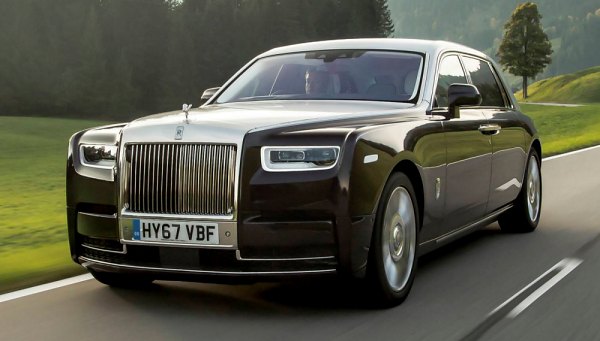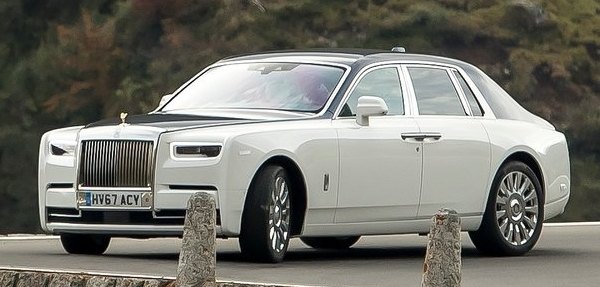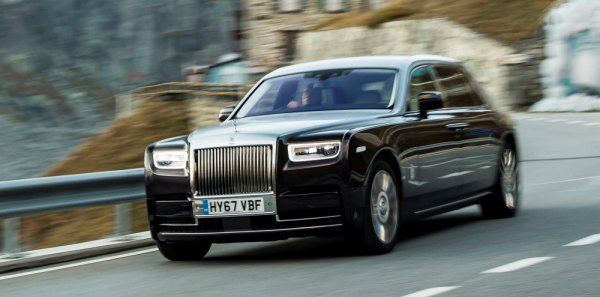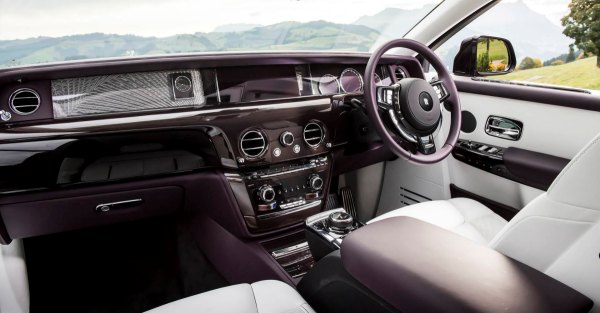| Published
on 2
Nov 2017 |
All rights reserved.
|
|
|

|
|
At
92 years old, is Phantom still "the best car in the world" ?
|
|
Phantom, what a historic
name! Rolls-Royce has been using the nameplate on its range-topping
model since 1925, when it replaced the
famous Silver Ghost.
Naturally, it was dubbed “the best car in the world”, but in fact it
suffered from a philosophy emphasizing too much on tradition and
conservative taste. Although it evolved through 6 generations from 1925
to 1990, it actually changed little since 1959. The lack of progress in
technology and production method left it behind Mercedes 600 Pullman
in
the 1960s and the nameplate was gradually forgotten by the world.
In 2003, BMW took over Rolls-Royce and resurrected Phantom as its sole
model. In response to doubt about the true identity of the car –
especially when it was built at the new Goodwood factory instead of
Crewe, with most mechanicals shipped directly from Germany – it opted
for a very
conservative design that drew strongly from the past. We didn’t like
its styling, but that matter little to RR because it won the approval
of the world’s wealthiest
people, many of whom were happy customers of the old Rolls-Royce.
Modern mechanicals wrapped in a new aluminum chassis finished with
impeccable build quality, craftsmanship and insulation made the reborn
Phantom sounded and smelt every bit a traditional Roller. Mission One
accomplished.
In the second incarnation, the Phantom VIII continues to act as the
company’s flagship luxury saloon, sitting comfortably above the cheaper
and higher volume Ghost. It starts from £360,000 for
short-wheelbase body or £432,000 for extended wheelbase. Even so,
most customers will add tens of thousand pounds of options and
customizations such that some may even exceed a million pounds! This
car easily trumps Bentley Mulsanne and Mercedes-Maybach S650 to be the
world’s most luxurious limousine.

|
|
This
car easily trumps Bentley Mulsanne and Mercedes-Maybach S650 to be the
world’s most luxurious limousine.
|
|
Styling of the new Phantom is hardly new. In fact, it looks very much
like the old car which had been soldiering for 14 years. The world of
automotive design progresses rapidly, but time seems standing still at
Rolls-Royce, especially on its flagship model. Understandably, the very
rich buyers of this car are mostly old and super-conservative – I
suspect very few are younger than 50s. Anyway, the Phantom VIII keeps
the old car’s tall and blocky proportion. Its front end is
waterfall-straight. Its aerodynamic drag is about as good as a gold
brick. This car is so rich of everything that it can ignore the laws of
physics or the requirements for efficiency. Only in this way it can
show how rich and flamboyance it is!
However, there are still some noticeable changes. Up front, the
prominent radiator grille is slightly raked and rounded to flow flush
with the bonnet. The headlamps are still recessed slightly from the
main surface, but now they employ LED and laser beams and are
surrounded with fancy-looking LED rims. At the back, the boot lid and
rear window are more steeply raked, not to improve aerodynamics but to
resemble the classic Phantom V
and VI. Do we like its styling? No, not
a bit, but just as before, this car has real presence. Even with the
largest 22-inch wheels fitted, it still looks incredibly huge, tall and
heavy, a lot more so than a Bentley or Maybach, although its actual
weight and dimensions are not so much.

|
|
This
car is so rich of everything that it can ignore the laws of physics or
the requirements for efficiency.
|
|
At 5762mm long,
2018mm wide, 1646mm tall and 3552mm in wheelbase, this is a huge car by
any standards. Yet this is only the “short-wheelbase” version. Extended
Wheelbase model adds another 220mm to both its wheelbase and overall
length but only a weight penalty of 50 kg. Like the old car, the
chassis is an all-aluminum spaceframe while the body panels are
all-aluminum as well. However, this is an all-new architecture that
will serve also the next generation Ghost, Wraith, Dawn and Cullinan
SUV, or simply the entire Rolls-Royce family. Although it does not
employ any carbon-fiber elements, unlike the BMW 7-Series of the same
group, its rigidity is still lifted by 30 percent. Rolls-Royce improves
NVH suppression further by a lot of measures, such as applying 130 kg
of sound insulating materials, using foam-filling double-aluminum skins
at the floor and bulkheads, 6mm-thick double glazing windows and even
specially developed Continental tires with a foam layer to absorb road
noise. The result is 5dB reduction of noise level in the cabin, which
is remarkable as the old car was already one of the quietest cars in
the world.
The chassis rides on a new double-wishbone front axle and 5-link rear
axle. Adaptive dampers and self-levelling air suspensions are standard
again, but the air chambers are doubled in size for better cushioning.
Moreover, it is linked to the new Magic Carpet Ride technology, which
is BMW’s version of Mercedes Magic Body Control. It uses a 3D camera
mounted at the windscreen to scan the road ahead and adjust the
suspension stiffness accordingly. Besides, the suspension is added with
active anti-roll bars, not to make the Phantom a sports saloon in any
sense but to enable a softer suspension setting without risking
cornering control. Also taken from the parts pool of BMW 7-Series is
the active rear-wheel steering. Its chief purpose is to shorten the
turning circle at low-speed maneuver or parking, which is very useful
for a car so huge.

|
|
You
rarely need to engage more than a quarter of throttle travel or spin
the V12 higher than 2500 rpm, even on highway.
|
|
The V12 engine keeps its displacement
at 6.75 liters as in the long tradition of Rolls-Royce, but it is now
added with twin-turbochargers like Ghost (which displaces 6.6 liters).
In fact, it is the long-stroke version of the Ghost and M760Li engine.
It produces 571 hp at 5000 rpm and 664 lbft of torque from 1700 rpm,
the latter is considerably stronger than its siblings, which is exactly
what its extra weight needs. Pushing the 2.6 tons of mass, 0-60 mph can
be accomplished in a decent 5.1 seconds, nearly a second inside the
time of the old car, although hopeless to match the sportier Bentley
Mulsanne or Maybach S650. No, the Rolls-Royce Phantom has never meant
to be sporty. Instead, its huge reserve of power is just made to allow
the engine working unstressed in any normal driving conditions. You
rarely need to engage more than a quarter of throttle travel or spin
the V12 beyond 2500 rpm, even on highway. In this way, you can
enjoy impeccable refinement. The engine is barely audible in startup.
The suspension, road and wind noises are only noticeable for their
absence. Yes, this is easily the quietest car in the world!
The ZF 8-speed automatic transmission is again linked to GPS to predict
the road ahead. Like the V12 engine, its gearshifts are creamy smooth
and imperceptible. Plant the throttle, the engine and transmission
takes a moment to gather rev as there is no such thing called “Sport”
mode in this car, neither does it have paddle shift. However, once it
responds, the progress feels brisk and the V12 emits a satisfying,
albeit muted, roar. Although it does not encourage, passing is
effortless at any speed.

|
|
"The
Gallery" is a clever idea, lifting customization to a new height.
|
|
Inevitably,
driving excitement is limited in such a big, fully insulated car. The
oversized steering wheel is not what you would call sporty or handy,
but
the boss at the rear bench must be quite amused to watch his chauffeur
working hard to guide the car. The steering is actually light and muted
but surprisingly precise. The brake pedal is well weighted, if the
inital response is too soft. You sit very high as in a lorry, have a
good view on the road over the long and square bonnet (the flying lady
aids judging the front end, by the way). The suspension setting is very
soft
and the car’s center of gravity is high, leading to more body roll in
corners than the usual norm of German luxury limousines. However,
ultimately the active anti-roll bars will limit the roll should you
drive the car outside its comfort zone, although you will keep sliding
across the flat chair. For such a huge car, its body control is
respectable, and you can guide it on winding roads with remarkable
precision, thanks to 4-wheel steering. There is a sense of precision
unfound on the old Phantom, and an agility matching the smaller Ghost.
Having said that, without much feel from the steering, much noise from
the engine and no road feedback from your seat of the pants, the
Phantom
never encourages you to drive it in a spirited mood.
Meanwhile, ride comfort is simply peerless. The comfort-oriented
suspension setting results in a supple ride over a variety of surfaces,
including some very bad mountain roads. The predictive Magic Carpet
Ride certainly helps, as does the car’s rigid chassis.

|
|
Those
heavy lacquer, flashy interior details and contrasting colors remind us
the lifestyle of parvenus...
|
|
However, in the
eyes of its maker and buyers, the best thing about the Phantom has to
be its cabin. Bentley and Maybach praised their cars for bespoke
design, impeccable craftsmanship and endless customization, but they
are nowhere close to the territory of Phantom. First of all, you enter
the
rear seat gracefully through a huge rear-hinged door, which is
electrically triggered by a soft button. You sit way back on the
high-mounted rear seat, which is soft, cosset, heated and massaged. The
leather is soft and the carpet is thick. Privacy is guaranteed by the
thick C-pillars, while view over the front cabin and windscreen is
commanding. Needless to say, head and legroom are vast. Unless you need
the reclining lounge chairs or to show your wealth, there is really no
need to opt for the EWB model. Each rear passenger gets a fold table
and individual infotainment system with dedicated controls. They are
also served with a cooled wine cabinet with whisky glasses. The
leather, wood and metal employed are all expensive stuffs. Fit and
finish are faultless. The roof liner is decorated with a thousand LED
starlights. All in all, it smells luxury and flamboyant.
As for customization, apart from various two-tone paint schemes to
choose from, Rolls-Royce added a clever feature called “The Gallery” to
the dashboard. A big piece of glass runs the full width of the
dashboard, covering the TFT instruments, infotainment screen as well as
a dedicated area on the passenger side for installing your selected
artworks
during the
assembly. These can be your own collection of oil painting, sculptures,
ceramics, silk… or one of the options offered by Rolls-Royce. Hopefully
this will allow many Chinese customers to put the portraits of Chairman
Xi into the dash as an evidence of their loyalty, and by the way remind
the chauffeurs that they are being watched by the Big Brother.
It would have been even better if the "The Gallery" could extend to the
rear – how about displaying a tiger skin on the roof or an ivory on
each rear door?
Objectively speaking, the new Phantom is clearly "the best car in the
world" when it comes to luxury and comfort, but then at more than twice
the price
of a Maybach and 60 percent more than a Mulsanne, it should be the
best. My only criticism about the Phantom is its attitude. Isn’t it too
flamboyant, too show-off? That imposing front end is exaggerating to
the extent of disgusting. Those heavy lacquer, flashy interior details
and contrasting colors remind us the lifestyle of parvenus. Rich people
lived in that way at the eve of the 1929 Wall Street crash. The
revival of Phantom reminds us how wrong the world is heading to.
|
Verdict:     |
|